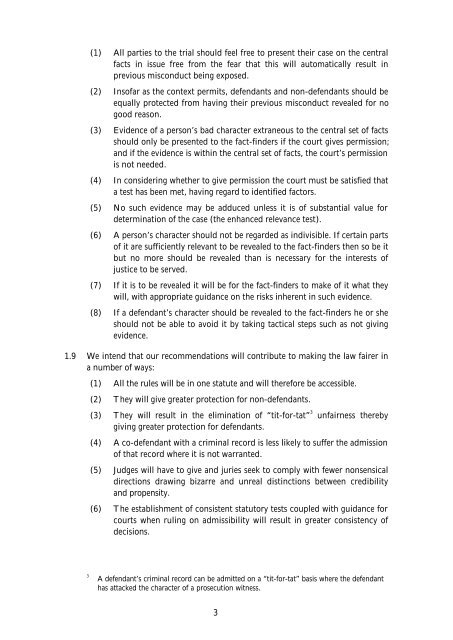Evidence of Bad Character in Criminal ... - Law Commission
Evidence of Bad Character in Criminal ... - Law Commission
Evidence of Bad Character in Criminal ... - Law Commission
You also want an ePaper? Increase the reach of your titles
YUMPU automatically turns print PDFs into web optimized ePapers that Google loves.
(1) All parties to the trial should feel free to present their case on the central<br />
facts <strong>in</strong> issue free from the fear that this will automatically result <strong>in</strong><br />
previous misconduct be<strong>in</strong>g exposed.<br />
(2) Ins<strong>of</strong>ar as the context permits, defendants and non-defendants should be<br />
equally protected from hav<strong>in</strong>g their previous misconduct revealed for no<br />
good reason.<br />
(3) <strong>Evidence</strong> <strong>of</strong> a person’s bad character extraneous to the central set <strong>of</strong> facts<br />
should only be presented to the fact-f<strong>in</strong>ders if the court gives permission;<br />
and if the evidence is with<strong>in</strong> the central set <strong>of</strong> facts, the court’s permission<br />
is not needed.<br />
(4) In consider<strong>in</strong>g whether to give permission the court must be satisfied that<br />
a test has been met, hav<strong>in</strong>g regard to identified factors.<br />
(5) No such evidence may be adduced unless it is <strong>of</strong> substantial value for<br />
determ<strong>in</strong>ation <strong>of</strong> the case (the enhanced relevance test).<br />
(6) A person’s character should not be regarded as <strong>in</strong>divisible. If certa<strong>in</strong> parts<br />
<strong>of</strong> it are sufficiently relevant to be revealed to the fact-f<strong>in</strong>ders then so be it<br />
but no more should be revealed than is necessary for the <strong>in</strong>terests <strong>of</strong><br />
justice to be served.<br />
(7) If it is to be revealed it will be for the fact-f<strong>in</strong>ders to make <strong>of</strong> it what they<br />
will, with appropriate guidance on the risks <strong>in</strong>herent <strong>in</strong> such evidence.<br />
(8) If a defendant’s character should be revealed to the fact-f<strong>in</strong>ders he or she<br />
should not be able to avoid it by tak<strong>in</strong>g tactical steps such as not giv<strong>in</strong>g<br />
evidence.<br />
1.9 We <strong>in</strong>tend that our recommendations will contribute to mak<strong>in</strong>g the law fairer <strong>in</strong><br />
a number <strong>of</strong> ways:<br />
(1) All the rules will be <strong>in</strong> one statute and will therefore be accessible.<br />
(2) They will give greater protection for non-defendants.<br />
(3) They will result <strong>in</strong> the elim<strong>in</strong>ation <strong>of</strong> “tit-for-tat” 3 unfairness thereby<br />
giv<strong>in</strong>g greater protection for defendants.<br />
(4) A co-defendant with a crim<strong>in</strong>al record is less likely to suffer the admission<br />
<strong>of</strong> that record where it is not warranted.<br />
(5) Judges will have to give and juries seek to comply with fewer nonsensical<br />
directions draw<strong>in</strong>g bizarre and unreal dist<strong>in</strong>ctions between credibility<br />
and propensity.<br />
(6) The establishment <strong>of</strong> consistent statutory tests coupled with guidance for<br />
courts when rul<strong>in</strong>g on admissibility will result <strong>in</strong> greater consistency <strong>of</strong><br />
decisions.<br />
3 A defendant’s crim<strong>in</strong>al record can be admitted on a “tit-for-tat” basis where the defendant<br />
has attacked the character <strong>of</strong> a prosecution witness.<br />
3

















